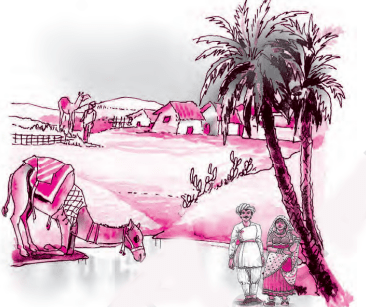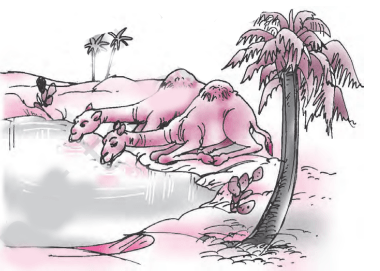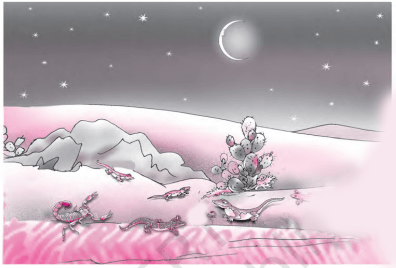Class 7 Chapter 3 The Desert Summary, Explanation along with Word Meaning and Question Answers from An Alien Hand Book
The Desert Class 7 – NCERT Class 7 English An Alien Hand book Lesson 3 The Desert Summary and Detailed explanation of the lesson along with the meanings of difficult words. Also, the explanation is followed by a Summary of the lesson. All the exercises and Questions and Answers given at the back of the lesson have been covered. Take Free Online MCQs Test for Class 7 Click Here
- The Desert Introduction
- The Desert Summary
- The Desert Summary in Hindi
- The Desert Explanation
- The Desert Question Answers
- The Desert Video Explanation
- Class 7 English Honeycomb Chapter Wise Word Meanings
- Class 7 English Honeycomb Book Poems Word Meanings
- Class 7 English An Alien Hand Chapter wise Word Meanings
The Desert Introduction
The lesson gives a detailed account of the geographical formation of deserts. We get to know about the climate, vegetation and animals and how they adapt to the extreme weather conditions found here.
The Desert Class 7 Video Explanation
The Desert Summary
The Desert Summary – The author describes life in a desert. He also makes us aware that people believe that deserts are stretches of sand which do not get rain or vegetation. It is dry, hot, waterless and shelterless but on the contrary, the desert is a beautiful place. Various people, animals and plants live here and have adapted to the hot and dry weather. Sometimes it rains in deserts and then, flowers grow there too. Deserts have hills also. Oasis which is like a green island in the middle of the desert and has a spring or a well and trees. A desert can be either hot or cold but both lack water and vegetation. Strong winds blow heaps of sand and lead to the formation of sand dunes. These keep on shifting and a few plants can survive them. As we know all lining beings need water, the plants and animals in deserts adapt to the scarce water condition prevelant. Camels, the ship of the desert can drink a lot of water at a time and then can remain without it for several days. camels sweat less. We sweat to maintain the body temperature but as Camels can resist high temperatures, the do not sweat and do retain the water for longer. The small desert animals do not drink water. They go into the underground burrows during the day. At night, they come out for food. They eat other animals and get water from the moisture in the flesh. If they eat plants, then the juice provides them fluid. The cactus plants in deserts store water in the thick stem. The roots are close to the ground and absorb moisture even from the small amount of rain. Deserts heat and cool rapidly because of the absence of a blanket of moisture. Deserts are important for our ecosystem just like the forests and oceans.
The Desert Summary in Hindi
लेखक रेगिस्तान में जीवन का वर्णन करता है। वह हमें इस बात से भी अवगत कराते हैं कि लोग मानते हैं कि रेगिस्तान रेत के खंड हैं जिनमें बारिश या वनस्पति नहीं मिलती है। यह शुष्क, गर्म, जलविहीन और आश्रयहीन है लेकिन इसके विपरीत रेगिस्तान एक खूबसूरत जगह है। विभिन्न लोग, जानवर और पौधे यहां रहते हैं और गर्म और शुष्क मौसम के अनुकूल हो गए हैं। कभी रेगिस्तान में बारिश होती है और फिर वहाँ भी फूल उग आते हैं।
रेगिस्तान में पहाड़ियाँ भी होती हैं। नखलिस्तान जो रेगिस्तान के बीच में एक हरे-भरे द्वीप की तरह है और जिसमें एक झरना या एक कुआँ और पेड़ हैं। रेगिस्तान गर्म या ठंडा हो सकता है लेकिन पानी और वनस्पति दोनों की कमी होती है। तेज हवाएं रेत के ढेर उड़ाती हैं और रेत के टीलों का निर्माण करती हैं।
ये हिलते रहते हैं और कुछ पौधे इनसे बच सकते हैं। जैसा कि हम जानते हैं कि सभी अस्तर प्राणियों को पानी की आवश्यकता होती है, रेगिस्तान में पौधे और जानवर दुर्लभ पानी की स्थिति के अनुकूल होते हैं। ऊंट, रेगिस्तान का जहाज एक बार में ढेर सारा पानी पी सकता है और फिर उसके बिना कई दिनों तक रह सकता है। ऊंट कम पसीना बहाते हैं। हम शरीर के तापमान को बनाए रखने के लिए पसीना बहाते हैं लेकिन चूंकि ऊंट उच्च तापमान का विरोध कर सकते हैं, इसलिए पसीना नहीं आता और पानी को लंबे समय तक बनाए रखते हैं। छोटे रेगिस्तानी जानवर पानी नहीं पीते हैं। वे दिन के दौरान भूमिगत बिलों में चले जाते हैं।.
रात में वे भोजन के लिए बाहर आते हैं। वे अन्य जानवरों को खाते हैं और मांस में नमी से पानी प्राप्त करते हैं। यदि वे पौधे खाते हैं, तो रस उन्हें द्रव प्रदान करता है। रेगिस्तान में कैक्टस के पौधे मोटे तने में पानी जमा करते हैं। जड़ें जमीन के करीब होती हैं और थोड़ी मात्रा में बारिश से भी नमी को अवशोषित करती हैं। नमी की चादर न होने के कारण रेगिस्तान तेजी से गर्म और ठंडा होता है। जंगल और महासागरों की तरह ही रेगिस्तान हमारे पारिस्थितिकी तंत्र के लिए महत्वपूर्ण हैं।
The Desert Explanation
Passage – THOSE of us who live in regions covered with forests and surrounded by hills may find it difficult to imagine what a desert is really like. The popular belief is that it is an endless stretch of sand where no rain falls and, therefore, no vegetation grows. It is dry, hot, waterless and without shelter. But this is not entirely correct. For those who have studied it, the desert can be a beautiful place. It is the home of a variety of people, animals and plants that have learnt to live under very hot and dry conditions.
Word Meaning
Regions: areas
Surrounded: covered
Variety: different kinds
Shelter: a place giving temporary protection from bad weather or danger
Explanation of the above Passage: Those people who live in areas with dense forests or in hilly areas may not be able to imagine desert areas. Most people consider a desert to be an unending area of sand which gets neither rainfall nor vegetation. It is a dry, hot and waterless place which lacks any shelters. This is not completely true. Those who have studied about desert areas know that they can be beautiful. Deserts are home to several kinds of people, animals and plants which have adapted to the hot and dry conditions of the desert.
Passage: True, the ground is not always hidden by a cover of grass, plants and trees as it is in other climates. But whenever it rains, which is rare, desert flowers bloom and the sight can be as rewarding as that of any tropical garden. A desert is not always a flat, unchanging wasteland of dry sand. It may have mountains and hills. It may have an oasis, big or small. An oasis is like a green island in the middle of a desert where a spring or a well gives plants and trees a better chance to grow. A desert may be hot like the Thar or cold like Ladakh. But, generally speaking, if a place has little or no water and vegetation, people usually call it a desert. Some deserts are almost totally without water. In such places, strong winds blow raising heaps of sand and depositing them as mounds. These are called ‘sand dunes’ that shift and move endlessly across the desert. Few plants can survive on such dry, shifting sands.
Word Meaning
Bloom: grow and open
Sight: scene
Oasis: a fertile spot in the deserts where water is found
Mounds: big heaps
Survive: continue to live or exist
Explanation of the above Passage: It is true that in a desert the ground is not always covered with grass, plants or trees like in other climates but when it rains in a desert, the desert flowers grow and the scenery is as good as a tropical garden. Not all deserts are flat surfaces with barren land covered with sand. At times they can have mountains, hills and oases. An oasis is an area of fertile land with vegetation in the middle of the barren sand. There can be hot deserts like the Thar desert and cold deserts like Ladakh. In general terms, a place with scarce water and less vegetation is termed as a desert. Some deserts do not have any water. Such deserts have heaps of sand which are deposited by the blowing winds. These are called sand dunes and they shift and move across the desert. Only a few plants can grow on such a terrain of sand dunes.

Passage: All living things need water in order to survive. The few plants and animals that live in deserts have developed the ability to require less water than most plants and animals. The camel, popularly known as the ‘ship of the desert’, can drink a lot of water at one time. Camels can do without water for days together. The reason is they sweat very little. We sweat because we must keep our body temperature constant. We sweat when it gets hot, and this cools the body. Camels can stand high body temperature. They don’t need to sweat and can, therefore, retain the water they drink for long periods of time.
Word Meaning
Survive: continue to live or exist despite hardships
Retain: continue to have something
Explanation of the above Passage: In order to continue to remain alive, all living beings need water. However, the desert plants and animals have the ability to remain alive even if they get less water than the normal requirement. The camel is known as the ship of the desert because of its ability to drink a lot of water at a time and later, go on without water for many days. This is so because camels sweat less. One sweats in order to regulate the body temperature. Sweat keeps the body cool when the heat rises. Camels remain cool even in high temperatures and so they do not sweat much and thus, the water remains retained in their body.
Passage: The smaller desert animals do not drink water. They burrow underground during the hot day and come out at night to eat. Some of them eat other animals and get the water they need from the moisture in the meat. Others eat plants and seeds and get the water they need from plant juices.
 Word Meaning
Word Meaning
burrow: move underground by digging
moisture: wetness
Explanation of the above Passage: The smaller animals who live in deserts do not drink water. They remain in the underground burrows during the day. At night, they come out for food. Some animals eat other animals and get moisture from the flesh of the prey. While others eat plants and seeds and get water from the juice of the plant.
Passage: Desert plants also adapt themselves to the life they lead. Cactus plants store water in their thick stems. Their roots lie close to the surface of the ground and quickly absorb the moisture from the light rains that occasionally fall. The major feature of all deserts is, of course, dryness and variations of temperature. In humid climates, the moisture in the air acts like a blanket and protects the earth’s surface from the hot rays of the sun. The absence of this blanket in desertlands causes the desert to heat up rapidly during the day and to cool off rapidly at night.
Word Meaning
adapt: change
absorb: take in completely
variations: changes
humid: containing moisture
Explanation of the above Passage: The desert plants also change themselves according to the climate. The cactus plants store water in the stems. The roots are close to the ground surface and absorb after light rains. All desert regions have the common features of dryness and temperature variation. When humidity is high the moisture in the air acts like a blanket and protects the Earth’s surface from the hot Sun. There is no such blanket in deserts which causes them to heat up fast during the day and cool off likewise during the night.
Passage: Deserts are an important part of nature’s great plan. They are there like the dense forests and the deep oceans. Just because they are hot and dry, one should not look upon them as useless parts of the earth.
Explanation of the above Passage: Deserts are an important formation just like the forests and oceans. They are dry and hot but should not be considered useless.
The Desert Questions Answers
1. From the first paragraph
(i) pick out two phrases which describe the desert as most people believe it is;
(ii) pick out two phrases which describe the desert as specialists see it.
Which do you think is an apt description, and why?
A.
(i) it is an endless stretch of sand where no rain falls, It is dry, hot, waterless and without shelter
(ii) the desert can be a beautiful place; It is the home of a variety of people, animals and plants
The description given by experts seems apt because the desert contributes to maintain the ecological balance of the Earth.
2. The phrases on the left in the following box occur in the text. Match each of them with a phrase on the right.
| (i) an endless stretch of sand | fertile place with water and plants in a desert |
| (ii) waterless and without | not visible because the grass shelter is thick |
| (iii) an oasis | nothing but sand as far as one can see |
| (iv) hidden by a cover of grass | no water and no shade |
A.
| (i) an endless stretch of sand | nothing but sand as far as one can see |
| (ii) waterless and without | no water and no shade |
| (iii) an oasis | fertile place with water and plants in a desert |
| (iv) hidden by a cover of grass | not visible because the grass shelter is thick |
3. A camel can do without water for days together. What is the reason given in the text?
Camels drink a lot of water at a time and store it in the body. Also, they sweat less and so, they do not lose much water. Thus camels can go without water for many days.
4. How do the smaller desert animals fulfil their need for water?
The smaller desert animals live in underground burrows during the day. At night, they come out for food. They get water from the flesh of the animals that they prey on. Also, they get water from the plant juices of the plants that they eat.
5. In a desert the temperature rises during the day and falls rapidly at night. Why?
Deserts do not have a blanket of humidity which helps in regulating temperature. The blanket of moisture also protects the earth’s surface from Sun’s harmful rays. Thus in the deserts, the temperature rises and falls rapidly.
Top
Also See :
Honeycomb Book Lessons
- Three Questions Class 7 Chapter 1 Summary, Explanation, Question Answers
- A Gift of Chappals Class 7 English Chapter 2 Explanation, Summary and Question Answer
- Gopal and the Hilsa-fish Class 7 English Chapter 3, Summary, Question Answer
- The Ashes That Made Trees Bloom Class 7 English Chapter 4 Explanation, Summary, Question Answer
- Quality Class 7 English Chapter 5 Explanation, Summary, Question Answer
- Expert Detectives Class 7 English Chapter 6 Explanation, Summary, Question Answer
- The Invention of Vita-Wonk Class 7 English Chapter 7 Explanation, Summary, Question Answer
- Fire: Friend and Foe Class 7 English Chapter 8 Explanation, Summary, Question Answer
- A Bicycle in Good Repair Class 7 English Chapter 9 Explanation, Summary, Question Answer
- The Story of Cricket Class 7 English Chapter 10 Explanation
Honeycomb Book Poems
- The Squirrel Poem Class 7 Summary, Explanation, Question Answer
- The Rebel Class 7 English Poem 2 Explanation
- The Shed Class 7 English Poem 3 Explanation
- Chivvy Class 7 English Poem 4 Explanation
- Trees Class 7 English Poem 5 Explanation
- Mystery of the Talking Fan Class 7 English Poem 6 Explanation
- Dad and the Cat and the Tree Class 7 English Poem 7 Explanation
- Meadow Surprises Class 7 English Poem 8 Explanation
- Garden Snake Class 7 English Poem 9 Explanation
An Alien Hand Book Lessons
- The Tiny Teacher Class 7 English Chapter 1 Explanation
- Bringing up Kari Class 7 English Chapter 2 Summary, Explanation
- The Cop and the Anthem Summary Class 7, Explanation, Question Answers
- Golu Grows a Nose Summary Class 7, Explanation, Question Answers
- I Want Something in a Cage Summary Class 7, Explanation, Question Answers
- Chandni Summary Class 7, Explanation, Question Answers
- The Bear Story Summary Class 7, Explanation, Question Answers